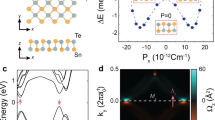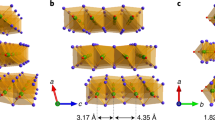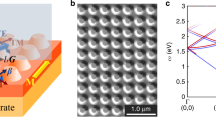Abstract
Tailoring of the propagation dynamics of exciton-polaritons in two-dimensional quantum materials has shown extraordinary promise to enable nanoscale control of electromagnetic fields. Varying permittivities along crystal directions within layers of material systems, can lead to an in-plane anisotropic dispersion of polaritons. Exploiting this physics as a control strategy for manipulating the directional propagation of the polaritons is desired and remains elusive. Here we explore the in-plane anisotropic exciton-polariton propagation in SnSe, a group-IV monochalcogenide semiconductor that forms ferroelectric domains and shows room-temperature excitonic behaviour. Exciton-polaritons are launched in SnSe multilayer plates, and their propagation dynamics and dispersion are studied. This propagation of exciton-polaritons allows for nanoscale imaging of the in-plane ferroelectric domains. Finally, we demonstrate the electric switching of the exciton-polaritons in the ferroelectric domains of this complex van der Waals system. The study suggests that systems such as group-IV monochalcogenides could serve as excellent ferroic platforms for actively reconfigurable polaritonic optical devices.
This is a preview of subscription content, access via your institution
Access options
Access Nature and 54 other Nature Portfolio journals
Get Nature+, our best-value online-access subscription
$29.99 / 30 days
cancel any time
Subscribe to this journal
Receive 12 print issues and online access
$259.00 per year
only $21.58 per issue
Buy this article
- Purchase on Springer Link
- Instant access to full article PDF
Prices may be subject to local taxes which are calculated during checkout






Similar content being viewed by others
Data availability
The data that support the plots within this paper and other finding of this study are available at the online depository Zenodo (https://doi.org/10.5281/zenodo.7395377).
References
Basov, D. N., Fogler, M. M. & de Abajo, F. J. G. Polaritons in van der Waals materials. Science 354, aag1992 (2016).
Zhang, Q. et al. Interface nano-optics with van der Waals polaritons. Nature 597, 187–195 (2021).
Low, T. et al. Polaritons in layered two-dimensional materials. Nat. Mater. 16, 182–194 (2016).
Fei, Z. et al. Gate-tuning of graphene plasmons revealed by infrared nano-imaging. Nature 487, 82–85 (2012).
Chen, J. et al. Optical nano-imaging of gate-tunable graphene plasmons. Nature 487, 77–81 (2012).
Dai, S. et al. Tunable phonon polaritons in atomically thin van der Waals crystals of boron nitride. Science 343, 1125–1129 (2014).
Caldwell, J. D. et al. Sub-diffractional volume-confined polaritons in the natural hyperbolic material hexagonal boron nitride. Nat. Commun. 5, 5221 (2014).
Hu, F. et al. Imaging exciton–polariton transport in MoSe2 waveguides. Nat. Photonics 11, 356–360 (2017).
Fei, Z. et al. Nano-optical imaging of WSe2 waveguide modes revealing light-exciton interactions. Phys. Rev. B. 94, 081402 (2016).
Ma, W. et al. In-plane anisotropic and ultra-low-loss polaritons in a natural van der Waals crystal. Nature 562, 557–562 (2018).
Zheng, Z. et al. A mid-infrared biaxial hyperbolic van der Waals crystal. Sci. Adv. 5, eaav8690 (2019).
Martin, L. W. & Rappe, A. M. Thin-film ferroelectric materials and their applications. Nat. Rev. Mater. 2, 16087 (2016).
Chang, K. et al. Discovery of robust in-plane ferroelectricity in atomic-thick SnTe. Science 353, 274–278 (2016).
Higashitarumizu, N. et al. Purely in-plane ferroelectricity in monolayer SnS at room temperature. Nat. Commun. 11, 2428 (2020).
Xiao, J. et al. Intrinsic two-dimensional ferroelectricity with dipole locking. Phys. Rev. Lett. 120, 227601 (2018).
Fei, Z. et al. Ferroelectric switching of a two-dimensional metal. Nature 560, 336–339 (2018).
Wu, M. Two-dimensional van der Waals ferroelectrics: scientific and technological opportunities. ACS Nano 15, 9229–9237 (2021).
Chang, K. et al. Microscopic manipulation of ferroelectric domains in SnSe monolayers at room temperature. Nano Lett. 20, 6590–6597 (2020).
Fei, R., Kang, W. & Yang, L. Ferroelectricity and phase transitions in monolayer group-IV monochalcogenides. Phys. Rev. Lett. 117, 097601 (2016).
Shi, G. & Kioupakis, E. Anisotropic spin transport and strong visible-light absorbance in few-layer SnSe and GeSe. Nano Lett. 15, 6926–6931 (2015).
Meléndez, J. J., González-Romero, R. L. & Antonelli, A. Quasiparticle bands and optical properties of SnSe from an ab initio approach. Comp. Mater. Sci. 152, 107–112 (2018).
Gruverman, A., Alexe, M. & Meier, D. Piezoresponse force microscopy and nanoferroic phenomena. Nat. Commun. 10, 1661 (2019).
Keilmann, F. & Hillenbrand, R. Near-field microscopy by elastic light scattering from a tip. Philos. Trans. R. Soc. A. 362, 787–805 (2004).
Zhao, L.-D. et al. Ultralow thermal conductivity and high thermoelectric figure of merit in SnSe crystals. Nature 508, 373–377 (2014).
Nguyen, H. T. et al. Temperature dependence of the dielectric function and critical points of -SnS from 27 to 350 K. Sci. Rep. 10, 18396 (2020).
Beal, A. R., Knights, J. C. & Liang, W. Y. Transmission spectra of some transition metal dichalcogenides. II. Group VIA: trigonal prismatic coordination. J. Phys. C. Solid State Phys. 5, 3540–3551 (1972).
Schmidt, T., Lischka, K. & Zulehner, W. Excitation-power dependence of the near-band-edge photoluminescence of semiconductors. Phys. Rev. B 45, 8989–8994 (1992).
Cassabois, G., Valvin, P. & Gil, B. Hexagonal boron nitride is an indirect bandgap semiconductor. Nat. Photonics 10, 262–266 (2016).
Zhou, J., Zhang, S. & Li, J. Normal-to-topological insulator martensitic phase transition in group-IV monochalcogenides driven by light. NPG Asia Mater. 12, 2 (2020).
Hu, F. et al. Imaging propagative exciton polaritons in atomically thin WSe2 waveguides. Phys. Rev. B. 100, 121301 (2019).
Kockum, A. F., Miranowicz, A., Liberato, S. D., Savasta, S. & Nori, F. Ultrastrong coupling between light and matter. Nat. Rev. Phys. 1, 19–40 (2019).
Luo, Y. et al. In situ nanoscale imaging of moiré superlattices in twisted van der Waals heterostructures. Nat. Commun. 11, 4209 (2020).
Rodrigo, D. et al. Mid-infrared plasmonic biosensing with graphene. Science 349, 165–168 (2015).
Autore, M. et al. Boron nitride nanoresonators for phonon-enhanced molecular vibrational spectroscopy at the strong coupling limit. Light. Sci. Appl. 7, 17172 (2017).
Hu, H. et al. Far-field nanoscale infrared spectroscopy of vibrational fingerprints of molecules with graphene plasmons. Nat. Commun. 7, 12334 (2016).
Acknowledgements
We thank A. Akey and J. Gardener at the Centre for Nanoscale Systems (CNS) at Harvard University for the TEM sample preparation and imaging. We thank Y. Han at Rice University for the helpful discussion on the TEM results. Part of the work was performed at CNS support by the National Science Foundation (NSF) under award no. ECCS-2025158. Y.L. was supported by the US Department of Energy under award no. DE-SC0019300. N.M. and J.K acknowledge the support by the US Department of Energy, Office of Science, Basic Energy Sciences under award no. DE-SC0020042 and the support from the STC Center for Integrated Quantum Materials, NSF grant number DMR-1231319. X.J. and J.K. acknowledge the support from the US Army Research Office (ARO) MURI project under grant number W911NF-18-1-0432. D.D., H.P. and P.K. acknowledge support from US Air Force Office of Scientific Research grants (nos. FA2386-21-1-4086 for P.K. and FA9550-17-1-0002 for H.P.). H.P. and P.K. acknowledge support from Department of Defense Vannevar Bush Faculty Fellowship (grant nos. N00014-16-1-2825 for H.P. and N00014-18-1-2877 for P.K.), Samsung Electronics and the NSF (PHY-1506284 for H.P.)
Author information
Authors and Affiliations
Contributions
Y.L., N.M. and W.L.W. conceived the experiment, Y.L., N.M., J.K. and W.L.W. planned the investigations. N.M., M.H-.C. and X.J. fabricated the pristine SnSe samples and carried out preliminary characterizations with J.K. and V.T. D.D. and Y.L. fabricated the device samples. Y.L. carried out the s-SNOM and LPFM experiments and analysed the data with N.M., J.K. and W.L.W. D.D. and Y.L. carried out the transport measurements under supervision of P.K. and H.P. Y.L. performed theoretical calculations and finite-difference time domain simulations. K.W and T.T provided the h-BN crystal. All authors discussed results and wrote the manuscript.
Corresponding author
Ethics declarations
Competing interests
The authors declare no competing interests.
Peer review
Peer review information
Nature Nanotechnology thanks Cheng-Wei Qiu and the other, anonymous, reviewer(s) for their contribution to the peer review of this work.
Additional information
Publisher’s note Springer Nature remains neutral with regard to jurisdictional claims in published maps and institutional affiliations.
Supplementary information
Supplementary Information
Supplementary Notes 1–10.
Rights and permissions
Springer Nature or its licensor (e.g. a society or other partner) holds exclusive rights to this article under a publishing agreement with the author(s) or other rightsholder(s); author self-archiving of the accepted manuscript version of this article is solely governed by the terms of such publishing agreement and applicable law.
About this article
Cite this article
Luo, Y., Mao, N., Ding, D. et al. Electrically switchable anisotropic polariton propagation in a ferroelectric van der Waals semiconductor. Nat. Nanotechnol. 18, 350–356 (2023). https://doi.org/10.1038/s41565-022-01312-z
Received:
Accepted:
Published:
Issue Date:
DOI: https://doi.org/10.1038/s41565-022-01312-z
This article is cited by
-
Recent advances in memristors based on two-dimensional ferroelectric materials
Frontiers of Physics (2024)
-
Stability of mechanically exfoliated layered monochalcogenides under ambient conditions
Scientific Reports (2023)
-
Vapour-phase deposition of two-dimensional layered chalcogenides
Nature Reviews Materials (2023)



